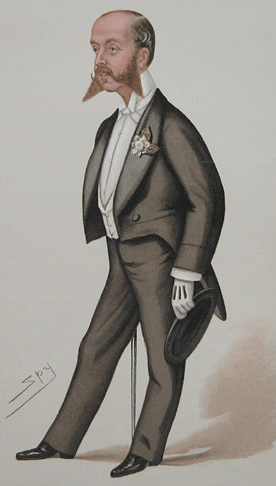Alfred de Rothschild facts for kids
Quick facts for kids
Alfred de Rothschild
|
|
|---|---|

Alfred de Rothschild, by Leslie Ward, 1884
|
|
| Born |
Alfred Charles de Rothschild
20 July 1842 England
|
| Died | 31 January 1918 (aged 75) England
|
| Resting place | Willesden Jewish Cemetery |
| Education | King's College, London, Trinity College, Cambridge |
| Occupation | Banker, consul, art collector, philanthropist |
| Board member of | N M Rothschild & Sons, Bank of England, National Gallery, Wallace Collection |
| Partner(s) | Marie Boyer |
| Children | Almina |
| Parent(s) | Lionel Freiherr de Rothschild Charlotte von Rothschild |
| Awards | Royal Victorian Order (1902) Legion of Honour Order of the Crown (Prussia) Order of Franz Joseph |
Alfred Charles de Rothschild (born July 20, 1842 – died January 31, 1918) was an important member of the famous Rothschild family. He was the second son of Lionel de Rothschild and Charlotte von Rothschild. Alfred was a successful banker, a collector of art, and someone who gave a lot to charity.
Contents
Early Life and Education
Alfred went to King's College School in Wimbledon when he was young. Later, he studied Mathematics at Trinity College, Cambridge. While at Cambridge, he became good friends with the Prince of Wales, who later became King Edward VII. Alfred left the university without finishing his degree.
Banking Career
When Alfred was 21, he started working at the N.M. Rothschild Bank in London. This is where he learned all about banking from his father. He also met many important people in the banking world across Europe.
In 1868, at age 26, Alfred became a director of the Bank of England. He held this important job for 20 years, until 1889. He was the first Jewish person to be a director of the Bank of England. After he left, no other Jewish person held that position for over 50 years.
In 1892, Alfred represented the British Government at a big meeting about money in Brussels. He also helped with talks between British and German leaders before the First World War. He even served as the Consul-General for Austria in London.
Halton House
When his father passed away in 1879, Alfred inherited a large estate in Halton, Buckinghamshire. Since he didn't have a country home there, Alfred decided to build a grand house. He built Halton House, which looked like a French castle. Construction started around 1880 and finished in July 1883. Alfred mostly used Halton House for parties and social events.
Honours and Awards
Alfred de Rothschild received many awards for his work. King Edward VII made him a Commander of the Royal Victorian Order (CVO) in 1902. He also received the Legion of Honour from France. Prussia gave him the 1st Class Order of the Crown. He was also given the Grand Cross of the Order of Franz Joseph from Austria-Hungary.
Philanthropy and Art
Alfred was a big supporter of the arts. He gave money to the National Gallery, London to help them buy new artworks. He was also a trustee for both the National Gallery and the Wallace Collection, which are famous art museums.
His Daughter, Almina
Alfred de Rothschild had a daughter named Almina. Alfred was her guardian and looked after her.
In 1895, when Almina was 19, she married The 5th Earl of Carnarvon. Alfred gave her a very large sum of money, about £500,000 (which would be worth much more today). This money helped her husband keep his family home, Highclere Castle, and pay off his debts. Alfred continued to support Almina financially throughout his life.
Almina's money later helped her husband pay for his important trips to Egypt. These trips led to the amazing discovery of Tutankhamun's tomb in 1922.
Alfred de Rothschild passed away on January 31, 1918, at the age of 75, after a short illness. He was buried in the Willesden Jewish Cemetery in North London. He left a large part of his wealth to his daughter, Almina.
See also
- History of the Jews in England
- Halton House
- Rothschild banking family of England
Images for kids


